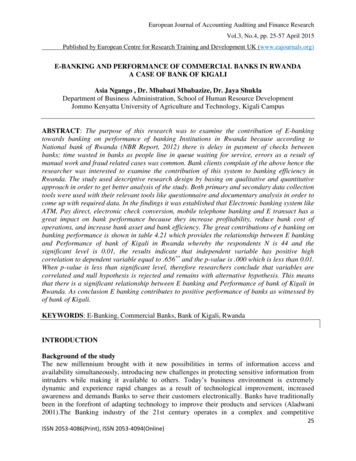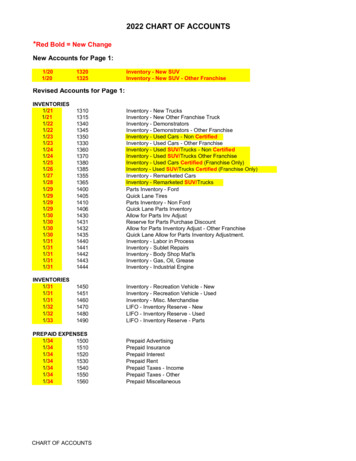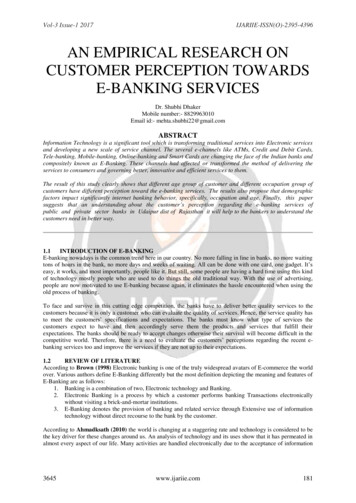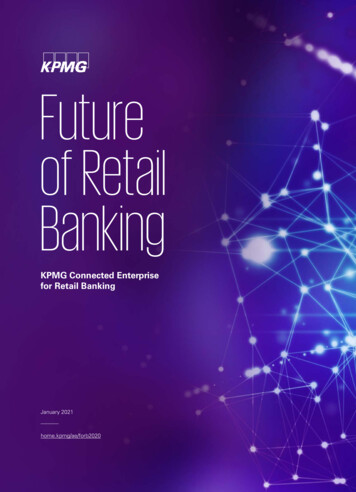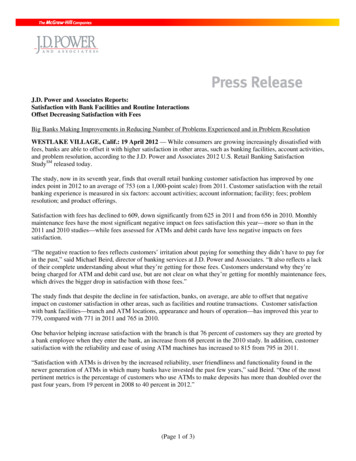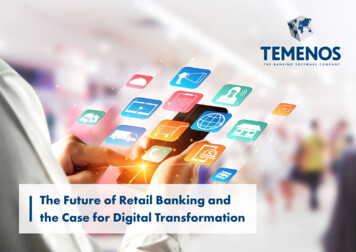
Transcription
The Future of Retail Banking andthe Case for Digital Transformation 1
ContentsExecutive Summary.31. Disruptive Technologies in Retail Banking.42. Increasing Pressures on the Retail Banking Industry.73. Structural Change – Disintermediation of the Retail Banking Chain.114. The Retail Banking Capability Model of the Future.135. The Current Reality and the Case for Digital Transformation.186. Strategies to Respond to Industry Pressures.217. A New Approach to Digital Transformation Using Disruptive Technologies.238. The Size of the Prize.28Conclusion.30Author & Acknowledgements.31 2
ExecutiveSummaryThe widespread uptake of disruptive new technologies is exacerbatingthe pressures facing retail banking today, thereby driving a fundamentalchange in the structure of the industry: the digital-driven disintermediationof the banking value chain. The COVID-19 pandemic has rapidlychanged consumer mindsets and circumstances driving banks to bothaccelerate and scale digital transformation and customer experienceacross complex product and customer journeys. Many incumbent banksare not equipped for this change because of the limitations of theircomplex legacy-based IT systems. Although banks have been investingheavily in digital and cloud technologies in recent years, they havebeen reluctant to embark on core system modernization. At Temenos,we believe that true digital transformation requires banks to replace theircore processing systems progressively with a cloud-native intelligentbanking platform designed for seamless scale and digital agility fosteringcontinuous innovation and a cost 10X lower than today. Without such amodern platform, it will no longer be possible to compete effectively in theindustry. The good news is that such transformations can now be executedeasily and with acceptable levels of risk, because of the Cloud and SaaSintelligent banking platforms coming into the market, built on API-first,microservices and DevOps principles offering automated migration anddeployment. 3
1Disruptive Technologiesin Retail BankingToday, a nexus of disruptive technologies is becoming omnipresent in banking as they lead to increased agility, elasticity and connectedness. Next generationcore banking platforms built on these technologies can deliver complex functionality 20X faster1 and are 10X cheaper to run2.In a survey3 we commissioned this year with the Economist Intelligence Unit (EIU) with 305 global banking executives relating to the digitization of banking,66% said that new technologies will continue to drive global banking in the next five years, over regulation and changing customer behavior.Cloud/SaaSAPIsMicroservicesDevOpsBig DataAI/MachineLearningBlockchain/Distributed DB1. McKinsey: Next generation technology transformation in financial services April 20202. Expert Interviews; Temenos analysis3. EIU Report 2020: “Forging new frontiers: advanced technologies will revolutionize banking 4
Cloud/SaaS: Cloud infrastructure offersbroad network access, resource pooling,rapid elasticity, high resilience and ondemand self-service for provisioning.By 2023, Cloud spend is projected torepresent 45% of the total enterprisespend of banks4. Moreover, COVID-19will accelerate this trend; 55% of CIOsindicate that they will increase Cloudadoption more than planned sinceCOVID-195. Beyond Cloud, consumingbanking software-as-a-service (SaaS) isexpected to grow at 10X the non-SaaSmarket for core banking6.4. IDC Report Worldwide ICT Spending Guide, IDC ReportWorldwide Public Cloud Services Spending Guide, 2018-20235. Flexera 2020 State of the Cloud report6. McKinsey Analysis on core banking market, Temenos financials,IDC, IBS7. McKinsey Insights: Cutting through the noise: How banks canunlock the potential of APIs8. McKinsey Insights: DevOps: The key to IT infrastructure agilityMicroservices/ APIs: An architectural and organizationalapproach to software development, microservices are independentlydeployable and updatable units of software that communicate overwell-defined APIs and are owned by self-contained teams. APIs area proven technology that integrate different IT systems and provideaccess to open data and secure access to private data and toenable 3rd party developers to build applications around the bank.Together microservices and APIs have multiple purposes – internallyto streamline and accelerate software development and simplifylegacy IT systems and externally to enable compliance with openbanking regulation and allow banks to connect with ecosystems ofrelated businesses, offering a significant opportunity to innovate anddevelop new products and services quickly. McKinsey estimatesthat the value at stake across global banking is significant —approximately 50% of revenues or 65% of profits (the money banksmake from distribution rather than manufacturing) over thecoming decades.7DevOps is the combination of agilecultural philosophies, practices, and toolsthat increases an organization’s ability todeliver applications and services at highvelocity. DevOps enables the introduction ofnew software faster and more predictablyusing continuous testing, integrationand deployment techniques rather thantraditional waterfall approaches. Benefitsaccording to McKinsey include a 25-30%increase in capacity creation, a 50-75%reduction in time to market, and a greaterthan 50% reduction in failure rates8.“Temenos was the only provider that was able to deliver on all three of our keyrequirements: cloud, interoperability and open APIs, with its world-class corebanking system that will scale with us as we grow.”– Minerva Tantoco, Co-Founder and CTO,Grasshopper Bank 5
Big Data: A bank’s ability to curate, manageand leverage big data, namely the vast storesof structured and unstructured information fromwithin the bank as well as from exogenoussources like social media sites, partners, suppliersand customers, is a key differentiator. McKinseyestimates that building on their long history ofleveraging data and sharpening analytics effortscould lead to an increase in earnings of as muchas 1 trillion annually for the global bankingindustry. The benefits would be widespread,but about a third of the gains would come fromreduced fraud losses and about 20% from betterinformed pricing and promotion.Artificial Intelligence (AI): This is predicted to bea game changer for banking in the future. 77% of ourEIU survey respondents think unlocking value from AIwill be the differentiator between winning and losingbanks. AI is predicated on automation and digitalizationwhich result in the accumulation of more and more dataabout customers and products combined with the easyavailability of analytic tools enabling banks to drawcommercially useful conclusions very quickly. AI’s efficacydepends on the depth of data (better accuracy) andbreadth of data (more complex use cases). For globalbanking, AI could potentially deliver up to 1 trillion ofadditional value each year, boosting revenues throughincreased personalization of services, lowering coststhrough efficiencies, and uncovering new and previouslyunrealized opportunities through the use of data, sayMcKinsey10.Blockchain: The distributed transactionvalidation model behind digital currencies,blockchain has not been widely adopted inretail banking in contrast to capital markets andwholesale banking. Nevertheless, there areapplications in cross-border remittances, KYC/ID fraud prevention, and risk scoring. McKinseyestimates that blockchains applied to crossborder payments could save about 4 billiona year and blockchain solutions in customeronboarding could create up to 1 billionof savings in operating costs for retail banksglobally and reduce regulatory fines by 2 to 3 billion11.9. McKinsey Insights: Smarter Analytics for Banks10. McKinsey Insights: The Executives AI Playbook11. McKinsey Insights: Blockchain and retail banking: Making the connection 6
2Increasing pressures onthe Retail Banking IndustryThe widespread uptake of the disruptive technologies, taken together, is exacerbating the pressures facing the retail banking industry – demanding customers,rise of new competitors and increasing levels of regulation. This is happening while the industry faces unprecedentedly tough market conditions significantlyworsened by the COVID-19 crisis that are not likely to ease in the foreseeable future.Reliability& TrustResponsiveness & ConvenienceRelevance – personalized offeringsPaymentspecialists“Tech-fin” - Technology giant Ecommerce platformsFinancial InclusionFintech - start-ups, neo-banks1. Demanding Customers2. Rise of New CompetitorsOpen Bankingand PSD2Instant paymentsCybersecurity & ResilienceBasel, IFRS, SOX, Dodd Frank3. Regulation and Market PracticeCOVID-19impactMarket & geopolitical valabilityEconomic slowdown and low proitabilityIncreased cyber crime4. Market Conditions 7
12Demanding Customers: Digital technologies facilitate repeated andincreasing customer interactions at multiple touchpoints both inside andoutside the bank (bank-owned channels as well as external portals), andcustomers want to seamlessly go back and forth across these in no particularsequence. It is no surprise then that customers journeys today are non-linear,complex, individual, spontaneous and unpredictable, instead of the traditionalstatic sequence of awareness, interest, decision and action that banks hardwired into their processes, IT systems and organization structures, often inproduct silos. Thus, banks must provide their customers as broad a choice asfeasible on what channel to engage on at every part of the journey.Rise of New Competitors: All the new entrants that are or have beenentering banking in the past few years share certain characteristics – they areall consumer-oriented, technology-driven companies that are leveraging thedisruptive technologies to develop compelling propositions for their customers.50% of our EIU survey respondents saw payment providers (Paypal, Alipay,Apple Pay) and technology and e-commerce disruptors (Amazon, Google,Facebook, Alibaba) as the biggest competition for the next 5 years. The latterbring massive distribution platforms and high-quality data to the table. BBVA’sCEO was prescient when he said almost 8 years ago, “If banks are notprepared for new competitors like Google, Facebook and Amazon, they facecertain death.” According to McKinsey13, 45% of the banking revenue poolis at risk to these new entrants who are cherry-picking the most profitablesegments of the banking value chain. For instance, up to 50% of payment andinvestment and 35% of consumer and SME lending business volumes could bedisintermediated by 202514.Retail customers demand more convenience, greater relevance and higherresponsiveness from their banks. They are less loyal and happy to shop aroundfor alternative providers of banking products and services for a better qualityof user experience and better value for money. 57% of consumers in the UKsaid in 2018 that they would go to multiple providers for their financial needsbased on the best proposition12. Customers are creating their own curatedbanking universe i.e. a virtual everyday bank which is a portfolio of cherrypicked offerings from multiple providers. As this happens and proprietaryrelationships and proprietary information become relegated to the past, thosebanks that proactively position themselves at the centre of this universe ratherthan those that find themselves at the periphery will be winners.12. PwC 2018 survey13. McKinsey Global Banking Annual Review 201914. Citi Research Global Digital Strategy “Bang and Fuse” Model 8
3Regulation and Market Practice: Ever since the credit crisis, banksare under ever-increasing scrutiny from local and global regulators,governments and credit agencies, with more rigorous financial reportingand risk management practices such as Basel III, MiFiD and Dodd-Frank.But today, regulation is no longer just about reporting and compliance. It iscausing banking operating models to fundamentally change. Regulators allover the world are driving innovation and competition through new standardsin open banking, issuance of new banking licences to non-traditional entrants,and creation of technology sandboxes for banks to collaborate with newplayers on innovative propositions. Regulators are also forcing banks to focuson cybersecurity – PSD2’s 2-factor authentication and GDPR’s digital IDSrequirements to manage consent and authorization are examples. Throughout2019, ECB Banking Supervision has continued to treat IT and cyber risks asa supervisory priority citing dependencies on end-of-life systems as a majorcause for concern. Banks recognize this – cybersecurity was cited as thebiggest challenge posed by digital and open banking today and their topinvestment priority according to this year’s EIU survey.4Market Conditions: Post-2008, the industry has struggled with historicallylow interest rates and margins caused by prolonged recessionary conditions,the debt crisis and increased geo-political volatility. This is reflected in thedrastic drop in average returns on equity since 2008, from above 20% tobelow 10% for the industry. We have found that in 2019, 70% of banksglobally earned a return on equity below their cost of equity and were valuedbelow their book value.The situation is not helped by the shift towards capital market financing drivenby regulators wanting banks to deleverage, driving up the cost of funds andby price pressures exerted by the new entrants. In Europe, traditional bankshave average cost-income ratios of 50-60%15, whereas the new digital-onlybanks are aiming for 30%.15. Calculated based on global average weighted by sector (Retail and Corporate / Mass Affluent / Wealth) in theTemenos Value Benchmark 2018 – Sources: McKinsey Global Banking Insights (02/18), Oliver Wyman Global WealthManagers (02/18) 9
Accelerated digital transformation since COVID-19: COVID-19 led to immediate changes in consumerbehaviour such as increased reliance on digital engagement for obvious reasons like inability to visit branches inlockdown conditions and the bulk of shopping moving online. COVID-19 has also created serious financial distressand anxiety for society so calls to banks have skyrocketed. This has led to customer traffic spilling over from branchesto call centres and from assisted to digital channels. Therefore, banks have been compelled to beef up their digitalcapabilities to handle many more interactions and transactions in terms of scalability, extend omni-channel capabilityto enable relationship managers and call centres to seamlessly engage, and ensure even complex customer journeyscan be handled completely digitally for all product lines and services, including those that may have been offered onlyin branches before the pandemic. So even one step in a customer journey or even one product that is not digital hasbecome a matter of survival in the COVID era.Behavioural scientists who have analysed previous crises caution that many of these mindsets and behaviours will outlastthe COVID-19 crisis. We can thus assume that the increased acceleration digital banking and engagement is likely tocontinue well beyond COVID-19.15%Increase in consumer digitaladoption (2-3 years worth)in 3 months1630-40%Reduction in cash usage16“Temenos will provide a completely remote installationin light of the Coronavirus pandemic, enabling us torealize our business goals and support SMEs with vitalfinancing in a matter of days.”– Mr. Mohammed R, Chairman,Al Ain Finance (UAE)“Our top priority in these unprecedented times issupporting our small business and commercial clients.With Temenos digital omnichannel capability, we wereable to build a brand new digital loan portal specificallyfor the U.S. Paycheck Protection Program (PPP) in lessthan a week.”- Kelly Dakin,Chief Digital and Customer Experience Officer,Atlantic Union Bank (USA)56%Consumers concerned about theirability to pay back loans1716. McKinsey Consumer Financial Pulse Survey April 202017. Lightco Customer Survey: Impact of COVID-19 on consumer banking March 2020 10
Structural Change –Disintermediation of the Retail Banking Chain3The chipping away of the banking value chain by non-traditional players plus the widespread consumption ofdigital banking services by technologically savvy, less loyal customers, combined with the high costs of operationof incumbent banks mean that the end-to-end manufacturing and distribution of banking services entirely withina bank will continue to decrease and that manufacturing and distribution will continue to diverge making itnecessary for banks to co-exist with and collaborate with other players of the eco-system, be they fintechs, telcos,retailers, technology giants or other banks. This unbundling of the banking value chain will only gather pace, as thedisruptive technologies mature in financial services. 11
Banks will need to assess which elements of their value chain truly add valueto the end customer and which do not, how much value is created, what arethe associated risks and costs and what are the opportunity costs of divestment.Accordingly, banks may decide to focus on certain processes themselves, mayconsider outsourcing and other innovative partnership models for sections oftheir value chain or may in-source certain business from other banks, leveragingeconomies of scale and leading to the rise of new utility models in the industry.Open banking will drive all banks towards focusing on what is really core tothem i.e. which business segments and geographies they want to operate in.Focus areas in the future will be extending private banking to the mass affluentand ultimately mass retail segments and extending corporate banking to theunderserved SME segment. Banks may choose to provide a full front-to-backservice in selected business lines or offer their own products to third-partydistributors or sell third-party products to their own customers. Thus, banks willco-exist with and co-evolve with multiple players in the banking eco-system,pursuing a combination of open banking business models. 12
4The Retail BankingCapability Model of the FutureIncumbent banks still possess an enormous competitive advantage over non-traditionalentrants. Their scale, connectivity, assets and special role as custodians of consumers’financial information put retail banks in a prime position to capture the market of the future.Being regulated means implicit state support in the shape of insured deposits and accessto central bank funding, resulting in lower costs of liquidity and raised barriers to entry.Historically, this has led to increased trust between the bank and the customer, but thetrust advantage is fast narrowing. Customer attitudes towards banking with technologycompanies have become more favourable in recent years.Banks are running out of time to seize the opportunity presented by the twin trends ofdigital and open banking which will entail fundamentally restructuring their business model,acquiring new competencies as well as improving their ability to execute.Percent of respondents who trust big techto handle financial needs1865%58%18. McKinsey Future of Banking Consumer Survey July 2019 13
Key banking capabilities in the digital and open banking age: The banking capability model today needs to balance between customer-drivendifferentiation in distribution and efficiency-driven standardisation in manufacturing, both of which are underpinned by front-to-back digitization and analytics.The insights held by banks are their core asset in today’s world and these are increasingly driven by AI which is infused into every aspect of the banking businessmodel, whether to launch hyper-targeted marketing campaigns and personalize products and experiences or to optimize processing and reduce operationalcosts and risks.Digitally augmentedcustomer experienceDistribution &channelsManufacturingFront-to-back digitization89%87%Omni - channelHarmonized, seamless,proactive, ven,omniscient, proactive88%Open bankingCollaboration withecosystem partnersvia APIs74%AnalyticsAnalytics91%87%Flexible, modularproduct enginesMasspersonalizationTailored productsand services90%Straight-through,real-time processing95%Scalable, secureinfrastructure (Cloud)88%Adaptive and resilientoperating modelEfficient and effective operationsX%Proportion of Temenos Value Benchmark* retail participants that rated the capability as top priority (4 or 5 out of 5 on importance)* Temenos Value Benchmark (TVB) is Temenos' proprietary survey-based strategic programme to discuss business performanceand value creation by a bank's investment in IT, structured around business and IT metrics and qualitative best practices. 14
Temenos Value Benchmark (TVB) participants confirm that digitizing the bank from the front through to the back and the bank-wide use of analytics are keycapabilities required to compete in the industry today.Front-to-back digitizationAnalyticsThis includes seamless on-boarding and origination, automated processingof transactions, payments and settlements from the front to the back as well asautomatic accounts reconciliation and billing processes. 89% of participantshave given this an importance rating of 4 or higher on a scale of 1-5. The TVBhas also revealed that the best performing banks in terms of cost-income ratiohave the highest levels of front-to-back digitization i.e. top performing banksare 26% more digital19 than the average performers, indicating that digitizationmaturity is a driver of financial performance.Analytics is about the fact that decision-making across the bank is supportedby user-friendly facts and data using descriptive/ diagnostic as well aspredictive/prescriptive analytics embedded into banking processes. 91% ofTVB participants have rated analytics as the highest priority. The TVB has alsorevealed that the best performing banks in terms of cost income ratio have thehighest levels of analytics usage i.e. top performing banks use analytics 23%more widely20 than the average performers, indicating that analytics maturity isa clear driver of financial performance.“Take the experience that we currently deliver to our bankers in face-toface channels and provide that same quality of experience through a digitalchannel. The big challenge often comes down to how do you personalize it andmake that experience different for every client and recognizing what makes itunique. And a big part of that comes down to data and AI.”- Jeff Wright,SVP Client solutions, Canadian Western Bank (Canada)19. Temenos Digital Index 0.25 x Digitally active customers (%) 0.25x Front Office STP rate (%) 0.25 x Operations STP rate (%) 0.25 x Payments STP rate (%)20. Temenos Analytics Index 0.5 x Analytics users (%) 0.5 x Analytics Reports per FTE (%) 15
The distribution end will focus on providing a digital customer experience that differentiates the bank from competition. It will have the followingcharacteristics:Omni-channel: Today’s full-service banks need to support multiplechannels, assisted and unassisted, internal and external. They must provide aconsistent experience and share intelligent data in real-time so transactionson one channel seamlessly continue on another. The focus has moved fromdriving customers towards lower cost digital channels to re-injecting intimacyinto these e.g. chatbots, hybrid video chats with human and digital touchpointsdelivered at scale. Multimodal channel capability i.e. combining more thanone channel into a single touchpoint are some of the newer challenges.Contextual user experience: Personalized and analytics-drivencustomer journeys are the cornerstone of the retail banking experiencetoday. A bank must hold a 360 degree view of the customer and understandcustomer behaviour at every touchpoint as well as preferences and spendinghabits. Real-time and predictive analytics are key in order to proactivelymonitor as well as dynamically change this behaviour by generating insightson next best interaction, propensity to buy or to leave and then usinggamification, for instance, to nudge a customer towards their financial goals. Itis a top priority for TVB participants (94%).Mass personalization: Customers want their own personalized setof products and services, designed and priced based on a 360 degreelifetime view, preferably via a self-service menu of mix-and-match options.Additional value-added offerings such as personal finance management toenable customers to gain insights into the spending and savings habits of theirpeers are being commonly used to personalize the customer experience.Mass personalization has been rated high by slightly fewer TVB participants(88%) because it depends on banks’ individual business models e.g., nicheplayers focusing on specialist products may not need to mass personalize.Open banking: A direct outcome of the disintermediation of the bankingvalue chain, open banking is now a global phenomenon, actively promotedby regulatory regimes in 40 countries. It is all about banks flexibly andseamlessly collaborating with 3rd party service providers or technologydevelopers via open APIs in a bid to deliver beyond banking lifestyle servicesto the end-customer. Examples include conveyance and home insurancebundled with mortgages or integrating a credit application on a real-estatewebsite. It entails banks having access to well populated and well curateddigital marketplaces to enhance and extend their functional capabilities withinnovative third-party solutions where appropriate. Open banking has beenrated high in importance by fewer TVB participants (74%) because it is stillnascent in many markets.“Leveraging Temenos deep market experience and its advanced cloudnative, cloud-agnostic and API-first technology, Next Bank will set thestandard for innovative digital banking and hyper-personalized customerexperiences.”- Wang Tun Chou,Chief Information Officer, Next Bank (Taiwan) 16
The manufacturing end will need to focus on efficient and effective operations. It will have the following characteristics:Flexible, modular product engines: Modern product architectures withre-usable product features, hierarchies and relationship pricing allow banks to offercustomer-centric, innovative feature-rich products that are quick to create and easy tomaintain. Speed to market in launching products at the manufacturing end enables testlaunches based on real-time customer feedback, targeted time-bound promotions andintroductory offers at the distribution end.Scalable, secure infrastructure (Cloud): Banks must be able to handlethe proliferation of increasingly complex customer interactions and transactionsengendered by digitization, open banking or contactless payments to acceptablelevels of performance. New business models mean unpredictability and rapidresponse to change which cloud-based infrastructures with auto-elasticity, hyperscaling and accelerated release cycles provide. Today, it is all about instances beingstood up or down in real-time. Active-active capability to move from one cloudplatform to another without downtime provides the highest levels of resilience. Today’sretail banks must have a multi-level cybersecurity framework including authentication,authorization, access and consent control as well as non-repudiation. Scalable andsecure infrastructure was cited as a top priority by 94% of TVB participants.“Temenos is a highly scalableplatform, it’s a secure platform andit’s a platform that the regulatorswere comfortable with.”- Colin Walsh,Founder & CEO, Varo Bank (USA)“Teme
estimates that building on their long history of leveraging data and sharpening analytics efforts could lead to an increase in earnings of as much as 1 trillion annually for the global banking industry. The benefits would be widespread, but about a third of the gains would come from reduced fraud losses and about 20% from better


